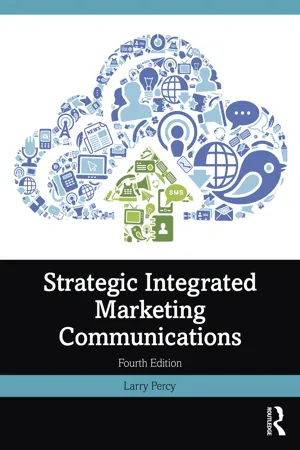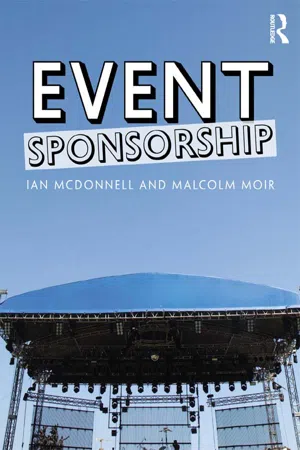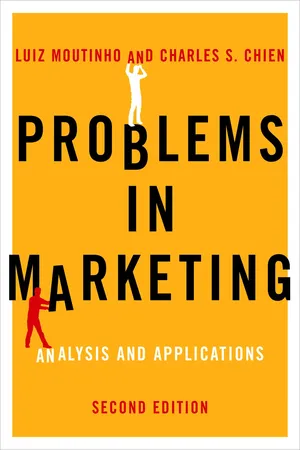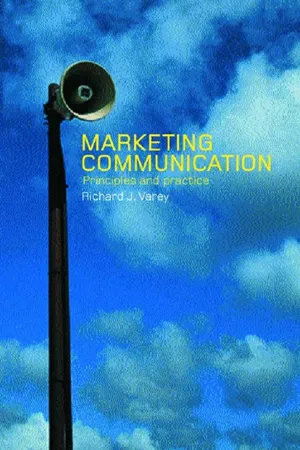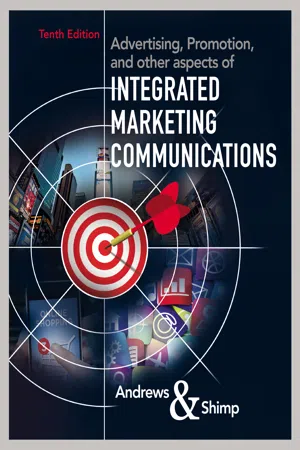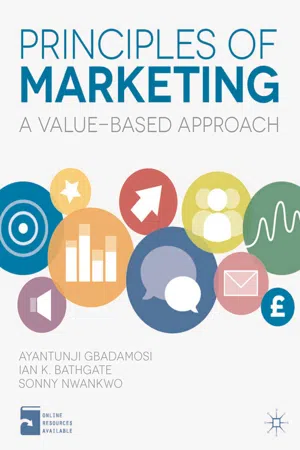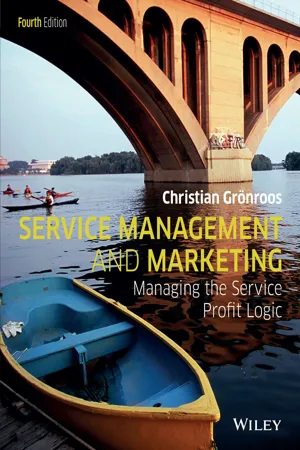Marketing
Integrated Marketing Communications
Integrated Marketing Communications (IMC) is a strategic approach that aligns and coordinates various marketing communication channels to deliver a consistent and unified message to target audiences. It aims to create a seamless and synergistic experience for consumers across different touchpoints, such as advertising, public relations, direct marketing, and digital media, to enhance brand awareness and engagement.
Written by Perlego with AI-assistance
Related key terms
1 of 5
11 Key excerpts on "Integrated Marketing Communications"
- eBook - ePub
- Larry Percy(Author)
- 2023(Publication Date)
- Routledge(Publisher)
Why do we bring this up at the beginning of a book on integrated marketing communication? When the idea of IMC emerged in the mid- to late 1980s it was something new, not just a new name for the practice of including various types of marketing communication options in a campaign; that is, it was new if correctly understood and implemented. Unfortunately, few companies seem able to truly implement effective IMC. We will touch on several of the key reasons for this later in this chapter. First, however, we need to understand just what is meant by integrated marketing communication (IMC).What is IMC?
We might briefly define IMC as the planning and execution of all types of advertising-like and promotion-like messages selected for a brand, service, or company, in order to meet a common set of communication objectives or, more particularly, to support a single ‘positioning ’. We believe strongly that the key to IMC is planning, and the aim is to deliver a consistent message, something that has become more and more difficult in the age of digital media, where the content of advertising for a brand may change frequently, even daily.Original definitions of IMC
In 1989, the American Association of Advertising Agencies (known as the 4As) formed a task force on integration that was to define IMC from the viewpoint of the 4As agencies. The task force came up with this definition of IMC:A concept of marketing communications planning that recognizes the added value of a comprehensive plan that evaluates the strategic roles of a variety of communication disciplines (e.g., general advertising, direct response, sales promotion, and public relations ) and combines these disciplines to provide clarity, consistency, and maximum communication impact.In the same year, the investment firm Shearson Lehman Hutton (1989) - eBook - PDF
Strategic Marketing Management in Asia
Case Studies and Lessons across Industries
- Syed Saad Andaleeb, Khalid Hasan(Authors)
- 2016(Publication Date)
- Emerald Group Publishing Limited(Publisher)
15 ▾ Integrated Marketing Communications Murali Manohar Bhupathi Communication is very critical for the success of an individual or an organization to convey an intended message to target recipients. In today ’ s fast emerging sce-nario of competitive marketing, any communication aimed at achieving specific goals with respect to sales promotion, advertising, direct marketing, public rela-tions, online promotions, and social media has to be planned and executed in a pro-fessional manner. Integration of various communication tools is vital to reach the target audience. This chapter discusses various types of communication tools. In additional it also delves into some ethical issues surrounding communication strategies. The American Marketing Association (AMA) defines Integrated Marketing Communications (IMC) as “ a planning process designed to assure that all brand contacts received by a customer or prospect for a product, service, or organization are relevant to that person and consistent over time. ” a Clow and Baack 1 portray a. https://www.ama.org/resources/pages/dictionary.aspx?dLetter=I 425 “ IMC as the coordination and integration of all marketing commu-nication tools, avenues, and sources within a company into a seamless program that maximizes the impact on consumers and other end users at a minimal cost. ” According to the American Association of Advertising Agencies (AAAA), IMC recognizes the value of a comprehensive plan that evaluates the strategic roles of a variety of communication disciplines — advertising, public rela-tions, personal selling, and sales promotion — and combines them to provide clarity, consistency, and maximum communication impact. Smith, Berry, and Pulford 2 defined IMC as follows: Management and control of all marketing communications. Ensuring that the brand positioning, personality, and mes-sages are delivered synergistically across every element of communication and are delivered from a single consistent strategy. - eBook - ePub
- Ian McDonnell, Malcolm Moir(Authors)
- 2013(Publication Date)
- Routledge(Publisher)
Chapter 5 Integrated marketing communicationLearning outcomes After reading and discussing the contents of this chapter, students will be able to: • define and describe integrated marketing communication (IMC); • show an understanding of how IMC has evolved and the levels of integration; • outline reasons for the growth in the IMC approach and how sponsorship fits.Introduction Integrated marketing communication (IMC) is the term applied to the concept that all forms of communication and messaging are carefully linked together. At its most basic level, IMC means integrating all the marketing tools, so that they work together in harmony. Here is more detailed explanation (Moore 1992, p. 1):IMC is the strategic co-ordination of multiple communication voices. Its aim is to optimise the impact of persuasive communication on both consumer and non-consumer (e.g. trade, professional) audiences by co-ordinating such elements of the marketing mix as advertising, public relations, promotions, direct marketing and package design.While sponsorship is not included in Moor’s examples of the marketing mix, it could easily be listed as one of these elements.Marketing tools work more effectively if they work together in harmony rather than in isolation. The outcome is greater than it would be if the marketing tools were not used to speak consistently with one voice all the time.BackgroundBefore we explore IMC in more detail here is a bit of background (Holm 2006). IMC became a hot topic in 1990s in the field of marketing. Four stages of IMC have been identified, starting from tactical co-ordination to financial and strategic integration. Holm’s (2006) research suggests that the majority of firms have not progressed beyond the first stages and very few have moved to a strategic level. In fact Kitchen (1997) stated that IMC ‘is progressing into acceptability and is becoming entrenched as perceived “academic wisdom” in general marketing’. - eBook - PDF
Marketing Communications
An advertising, promotion and branding perspective
- Geraldine Bell, Babek Taheri(Authors)
- 2017(Publication Date)
- Goodfellow Publishers(Publisher)
7 Integrated Marketing Communications Kitty Shaw If a brand like Apple supported a campaign about the impact on society of people spending too much time on their laptops and phones, or launched a very basic mobile phone would you think this was strange? This is because Apple has a very clear market positioning based on providing cutting edge technology products, which enhance people’s lives. This positioning is evident in everything from its sleek product design to all of its marketing and customer communications across multiple channels. All of their communications are integrated to support their market positioning and brand values. This chapter discusses Integrated Marketing Communications, why it is important for busi-nesses and how to go about delivering an integrated approach. The chapter also looks at the challenges of doing so and the future of integration. It links to the case study on Standard Life plc, which is included in Chapter 12. Integrated Marketing Communications is commonly abbreviated to IMC and this chapter will use this shorthand. Defining Integrated Marketing Communications The term ‘Integrated Marketing Communications’ was first coined in the 1990s and captured the need for marketers to co-ordinate their communications better, both across their different audiences or stakeholder groups, and their communications channels and promotional tools. Organisations may have worked with a number of specialist creative agencies or intermediaries for dif-ferent elements of their promotional mix, including advertising, direct mailings, public relations and sponsorship, while customer service communications were handled by another part of the organisation. IMC is about ensuring that all of these elements are joined up and present a unified positioning and image across all communications – both internal and external. - eBook - PDF
Marketing Communication NQF3 SB
TVET FIRST
- B Brown(Author)
- 2013(Publication Date)
- Macmillan(Publisher)
Topic 2 Integrated Marketing Communications 20 Module 3: Define Integrated Marketing Communications Module 3 Define Integrated Marketing Communications Overview When you have completed this module, you should be able to: • Unit 3.1: Define the concept Integrated Marketing Communications. • Unit 3.2: Discuss factors influencing integrated marketing communication. • Unit 3.3: Discuss the evolution of integrated marketing communication. • Unit 3.4: Describe the uses of integrated marketing communication. • Unit 3.5: List the steps in integrated marketing communication. • Unit 3.6: Explain the steps in integrated marketing communication. Unit 3.1: Define the concept Integrated Marketing Communications We can define Integrated Marketing Communications in several ways. Definitions include: • The collective arrangement of efforts and methods to sell a product or service, including advertising, sales promotions and trade shows. (www.highered.mcgrawhill.com/sites/0073080063/studentview0/ glossary.html). • Where all aspects of a company’s promotional efforts work together with a unified purpose to deliver a consistent and positive message. (www.woopr.net/glossary.aspx). • A fancy term for marketing that takes into account all the different media and aspects of communications that should be considered anyway. (www.neubertweb.com/definitions.html). Integrated Marketing Communications is more than just another way of describing the marketing mix. The clue lies in the word ‘communications’. People are the glue that joins the other marketing mix elements. Integrated Marketing Communications (IMC) is the air that keeps the whole process alive. It allows marketing messages to pass between a business and its customers, and prospective customers, in order to see products. Unified means made up of more than one thing. Words & Terms - eBook - PDF
Problems in Marketing
Applying Key Concepts and Techniques
- Luiz Moutinho, Charles S Chien(Authors)
- 2007(Publication Date)
- SAGE Publications Ltd(Publisher)
Thus it is concerned with identifying, establishing and maintaining relationships with various publics nationally , regionally , internationally and globally . These relationships pre-suppose regular monitoring of awareness, attitudes and behaviour inside and outside an organisation. 4 Publics able to impact organisational performance are not singular (i.e. consumers) but plural. This means analysing and adjusting corporate and marketing policies in line with public interests and with the concomitant focus on organisational survival and growth in a globalised market. Integrated marketing communication (IMC) was the major communication development in the last decade of the twentieth century. Just as businesses do not spring full-blown into the arena as global combatants, businesses do not suddenly decide to become integrated. More and more firms are considering communication the key competitive advantage of marketing per se, and we agree with them. IMC is a concept of marketing communication planning that recognises the added value of a comprehensive plan that evaluates the strategic role of a number of communication disciplines (e.g. general advertising, direct response, sales promotion and public relations) and combines these disciplines to provide clarity, consistency and maximum communication impact. IMC itself has been evolving with input from academics and practitioners around the world. A more succinct definition for the twenty-first century is suggested by Schultz and Kitchen (2000): IMC is a strategic business process used to plan, develop, execute and evaluate coordinated measurable, persuasive brand communication programs over time with consumers, customers, prospects, and other targeted, relevant external and internal audiences. Problems in Marketing 180 This definition first focuses on strategy – a strategy of communication that is clearly related to corporate mission, values and needs, but relates equally to brand mission, values and needs. - eBook - ePub
Marketing Communication
A Critical Introduction
- Richard Varey(Author)
- 2002(Publication Date)
- Routledge(Publisher)
thirteenINTEGRATED MARKETING COMMUNICATION
The din of modern advertising and the clamour of the mass media. Anon Consumers see the one brand but often hear it speaking different tongues, let alone in a variety of tones of voice. C. Robertson, advertising executiveLEARNING POINTSCareful study of this chapter will help you to: • appreciate the development of the integrated marketing communication (IMC) concept and managerial approach to marketing communication • consider the added value for provider and consumer/buyer of an IMC strategy • identify obstacles to practical IMCINTRODUCTION
For the majority of consumers, their attention is saturated with information, signs (images) and messages – these are both confused and impotent in their profusion and inconsistency. In contemporary society, mass media advertising rarely works well on its own.Relationship marketing is more communication intensive than traditional transaction-based marketing. Integrated marketing communication is a shift towards more personalized, customer-oriented, technology-supported marketing systems. This is managed by a brand-level, cross-functional team to integrate marketing and marketing communication activities. Brand management requires integration of systems of communication, especially when, as we saw in chapter twelve , a relationship-marketing strategy requires that customers are treated differently to prospective customers.Internal and external communicative activities/actions communicate whether or not they are done with the intention of communicating. Thus, planning for the comprehensive use of a range of activities that provide communication opportunities and coherent messages, recognizes that consumers and buyers do not see discrete advertising, public relations, and sales promotion.This theme of integration will be carried through our discussion of planning and evaluation in this book. The adoption of a true integrated marketing strategy requires, in many cases, a redesign of the business system to ensure that the making of promises and efforts to keep promises are coordinated. - J. Craig Andrews, Terence Shimp(Authors)
- 2017(Publication Date)
- Cengage Learning EMEA(Publisher)
3 © Jorg Hackemann/Shutterstock.com P art 1 introduces the fundamentals of Integrated Marketing Communications (IMC). Chapter 1 overviews IMC, what is meant by “marketing,” and discusses the importance of marketing commu-nications (marcom). Specifically, IMC emphasizes the need for integrating the promotional mix elements (advertising, sales promotions, personal selling, public relations, direct marketing, and digital marketing/social media) with each other and with the brand’s market-ing mix such that all speak with one voice. The chapter describes five key IMC features and presents a model of the marcom decision-making process. Chapter 2 explains how IMC enhances brand equity, influences behavior, and achieves accountability. Brand equity is then defined and the Brand Asset Valuator (with differentiation, relevance, esteem, and knowledge elements) is discussed in providing a measure of brand equity. The chapter also presents the relationships among brand concept (and how it is developed), brand equity, and brand loyalty. Chapter 3 examines marcom’s role in achieving acceptance for new products and how marketing com-municators facilitate product adoption and diffusion. Chapter 3 also provides detailed descriptions of the 1 An Overview of Integrated Marketing Communications 005 2 Enhancing Brand Equity and Accountability 025 3 Brand Adoption, Brand Naming, and Intellectual Property Issues 041 4 Environmental, Regulatory, and Ethical Issues 059 The Practice and Environment of Integrated Marketing Communications (IMC) Part 1 Copyright 2016 Cengage Learning. All Rights Reserved. May not be copied, scanned, or duplicated, in whole or in part. brand development process, including the requirements for a good brand name, the steps involved in arriving at a good name, and the role of logos. Important aspects of intellectual property (patents, copyrights, and trade-marks) affecting brands and marketing communications are then discussed.- eBook - ePub
Marketing Communications Management
Analysis, Planning, Implementation
- Paul Copley, Author(Authors)
- 2014(Publication Date)
- SAGE Publications Ltd(Publisher)
Integrated marketing and Integrated Marketing Communications (IMC) are not new concepts. Integration has been around for years with good practitioners, although it is the case that textbooks began to champion IMC in the early 1990s. Holm (2006) suggests that academics and professionals did not originally consider integration as a realistic approach, with much activity being anchored in little more than the tactical coordination of promotional mix elements. Holm echoes Schultz and Kitchen (2000) and others in suggesting the need for financial consideration and a strategic approach to IMC, which goes beyond the simplistic view of how IMC works; i.e. to concentrate solely on communications elements working together with a ‘unified message’, where below the line supports above the activity and vice versa. This is the drive toward cost effectiveness and where ‘careful planning creates marketing communications synergy which reinforces a consistent message or image in a cost effective manner’ (Smith, 1993). This was a good start, but has been taken further. IMC can be described as a process that involves various forms of communications that attempt to achieve tasks such as to persuade, inform, remind, educate or entertain customers and prospects, i.e. affecting and influencing the behaviour of target audiences. The IMC process also includes anything and everything that an organisation, company or its people and brands do with targets and publics, either deliberately or not. To make good use of all forms of relevant communication makes sense. All in all the IMC process, like the more general marketing process, should start and end with the customer or prospect. Like the marketing process the IMC process has been affected greatly by changes in technology whereby cost structures, communication effectiveness and client–agency/communication company relationships have been improved (Hughes and Fill, 2007).IMC has been defined as being a cohesive mix of promotional and other activities and tools that delivers a co-ordinated and consistent message to target customers and consumers synergistically to achieve organisational objectives (Kitchen and Schultz, 1999). There have been numerous studies during the past decade or so, all of which add to what is a fluid process as the IMC concept mutates. These include studies of the relationship between a specific element of the IMC mix, such as public relations, and those of the relationship between IMC and internal marketing issues. There have been numerous studies concerned with measurement and with media integration. All in all, for Kliatchko (2008), the concern has been to do with the ‘definitions, perceptions, understanding and theoretical foundations surrounding the IMC concept’. There is now interest in global perspectives but also those for IMC and branding, media synergy and internal marketing. Many writers have discussed the nature of IMC. A useful summary can be found in Pickton (2010) who pulls together various ‘models’. - eBook - PDF
Principles of Marketing
A Value-Based Approach
- Ayantunji Gbadamosi, Ian Bathgate, Sonny Nwankwo(Authors)
- 2013(Publication Date)
- Bloomsbury Academic(Publisher)
For example, personal selling has been carried out by the sales team, advertising by an agency, publicity activities by a public relations team. This can lead to variations in the message transmitted to consum-ers. The purpose of Integrated Marketing Communications is to ensure coordination between each element of the communications mix to deliver a coherent message to the target market. Sender: – The marketer – or nominated – representative – Advertising (PR) or – communications agency – After purchase – Via market research – Via social media – Via post/blog Sales Feedback Market share Creates a message: – Advert – Sales promotion – offers – In-store display – Sales pitch – Press release – Blogs posted in – social media Noise: – Competitor communications – Competitor store displays – General news and articles – Conversations on and offline Selects a channel: – Media – Store (retail) – Sales promotion – or wholesale – Sales representative Message is interpreted by receiver: – Customer – Other stakeholders – Media journalists – Business clients – Friends/followers – in social media Acts and or Stores for future reference or Disregards Figure 9.2: The communications process Source: Based on McDaniel et al., 2013 260 MARKETING COMMUNICATIONS STRATEGIES the need for Integrated Marketing Communications Integrated Marketing Communications have been defined by Dibb et al. (2012, p. 795) as ‘the coordination and integration of all marketing communication tools, avenues and sources within a company into a seamless programme that maximizes the impact on consumers and other end users, at minimal cost’. Organizations communicate with their target audience(s) primarily to inform, persuade and remind. Before any message can be created or media selected to carry the message, it is important to have information about the consumers belonging to each target audience group, from a number of perspectives. - eBook - PDF
Service Management and Marketing
Managing the Service Profit Logic
- Christian Gronroos(Author)
- 2016(Publication Date)
- Wiley(Publisher)
The messages that these parts of the customer relationship send may be more effective than those that the customer receives from advertisements, brochures and other traditional marketing communications media. However, to an overwhelming extent the literature on integrated marketing communication only includes commu- nication media where communication activities can be planned distinctly as communication. Furthermore, as conventional marketing communication is basically a firm-driven process, what is communicated is expected to be perceived more or less as intended. Obviously, in reality it may not be like this. A customer-driven communication approach is presented later in this chapter. As a true total communications approach, Integrated Marketing Communications, which is still firm-driven though, can be defined as follows: 3 Integrated Marketing Communications is a strategy that integrates traditional media marketing, direct marketing, public relations and other distinct marketing communications media as well as communications aspects of the delivery and consumption of goods and services and of customer service and other customer encounters. Thus, Integrated Marketing Communications has a long-term perspective. According to this definition, communication messages can originate from several sources. Duncan and Moriarty distinguish between four kinds of sources of communication messages: 4 1. Planned messages. 2. Product messages. 3. Service messages. 4. Unplanned messages. Planned messages are the result of a planned marketing communications campaign where separate communications media, such as TV, print, direct mail, the Internet, social media, etc., are used to send a message. Sales representatives also communicate planned messages. Generally, these messages are the least trustworthy, because people know that they are planned by the marketer to persuade customers and potential customers in a certain direction.
Index pages curate the most relevant extracts from our library of academic textbooks. They’ve been created using an in-house natural language model (NLM), each adding context and meaning to key research topics.
